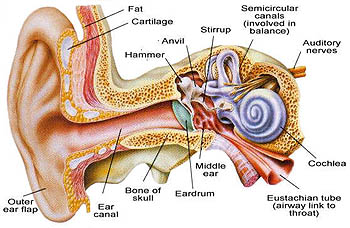Middle Ear Infection

There is nothing worse than when a baby or small child develops an ear infection. As our ears are a very sensitive part of the body, ear infections can be most uncomfortable and are often a painful experience.
The most common type of ear infection that develops in babies and young children is middle ear infection or otitis media, which relates to an infection behind the eardrum. This type of infection is usually caused by a viral or bacterial infection and often happens during or after a child has had a cold. Middle ear infection is more prevalent in young children because they are still building up their immunity system.
Four out of five children will develop a middle ear infection at least once. By the age of six, most children have grown out of middle ear infections and are not likely to suffer any long-term problems.
Ear infections can be detected by a number of symptoms including earache, fever, headaches, mild deafness and ear discharge. Mild deafness is caused by fluid or pus, which builds up in the ear canal behind the eardrum. Ear discharge occurs when the eardrum bursts because of the pressure behind it. Burst eardrums normally heal by themselves.
Some middle ear infections can also lead to a condition known as "glue ear" which involves thick fluid wedged in the middle of the ear. Having a glue ear can cause slight deafness but this will pass once the infection has cleared. In some cases, treatment may be needed. Recovering from a glue ear can take up to a few weeks, after the fluid has drained away.
As with adults, sometimes a child's ear can fill up with wax, hindering a child's hearing. The wax becomes lodged in the ear canal and the only way to remove it is by having a doctor gently syringe the wax plug out with warm water. This procedure doesn't hurt at all and a child will be as right as rain once the wax has been removed.
As children are quite resilient, in most cases, they can recover from mild ear infections in three to five hours. However, a child may show signs of tiredness afterwards, but this is quite normal.
Mild cases of ear infection can be treated quickly with Paracetamol. More severe cases of middle ear infection might require children to take a course of antibiotics, prescribed by a doctor. The use of eardrops may also be advised. Plugging a child's ears with cotton wool will stop any draft or further infection from getting into their ears.
Most ear infections will disappear in a short period of time but it is advisable that a child visits a doctor if:
- They have a high fever
- They have an ear discharge that lasts more than 24 hours
- They still have trouble hearing 6-8 weeks after initial ear infection
- Ear infection is becoming worse
- Annemarie Failla
The most common type of ear infection that develops in babies and young children is middle ear infection or otitis media, which relates to an infection behind the eardrum. This type of infection is usually caused by a viral or bacterial infection and often happens during or after a child has had a cold. Middle ear infection is more prevalent in young children because they are still building up their immunity system.
Four out of five children will develop a middle ear infection at least once. By the age of six, most children have grown out of middle ear infections and are not likely to suffer any long-term problems.
Ear infections can be detected by a number of symptoms including earache, fever, headaches, mild deafness and ear discharge. Mild deafness is caused by fluid or pus, which builds up in the ear canal behind the eardrum. Ear discharge occurs when the eardrum bursts because of the pressure behind it. Burst eardrums normally heal by themselves.
Some middle ear infections can also lead to a condition known as "glue ear" which involves thick fluid wedged in the middle of the ear. Having a glue ear can cause slight deafness but this will pass once the infection has cleared. In some cases, treatment may be needed. Recovering from a glue ear can take up to a few weeks, after the fluid has drained away.
As with adults, sometimes a child's ear can fill up with wax, hindering a child's hearing. The wax becomes lodged in the ear canal and the only way to remove it is by having a doctor gently syringe the wax plug out with warm water. This procedure doesn't hurt at all and a child will be as right as rain once the wax has been removed.
As children are quite resilient, in most cases, they can recover from mild ear infections in three to five hours. However, a child may show signs of tiredness afterwards, but this is quite normal.
Mild cases of ear infection can be treated quickly with Paracetamol. More severe cases of middle ear infection might require children to take a course of antibiotics, prescribed by a doctor. The use of eardrops may also be advised. Plugging a child's ears with cotton wool will stop any draft or further infection from getting into their ears.
Most ear infections will disappear in a short period of time but it is advisable that a child visits a doctor if:
- They have a high fever
- They have an ear discharge that lasts more than 24 hours
- They still have trouble hearing 6-8 weeks after initial ear infection
- Ear infection is becoming worse
- Annemarie Failla
MORE



